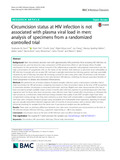| dc.description.abstract | Background
Male circumcision provides men with approximately 60% protection from acquiring HIV infection via heterosexual sex, and has become a key component of HIV prevention efforts in sub-Saharan Africa. Possible mechanisms for this protection include removal of the inflammatory anaerobic sub-preputial environment and the high concentration of Langerhans cells on the inside of the foreskin, both believed to promote local vulnerability to HIV infection. In people who do acquire HIV, viral load is partially determined by infecting partner viral load, potentially mediated by size of infecting inoculum. By removing a portal for virion entry, prior male circumcision could decrease infecting inoculum and thus viral load in men who become HIV-infected, conferring the known associated benefits of slower progression to disease and decreased infectiousness.
Methods
We performed an as-treated analysis of plasma samples collected under a randomized controlled trial of male circumcision for HIV prevention, comparing men based on their circumcision status at the time of HIV acquisition, to determine whether circumcision is associated with lower viral load. Eligible men were seroconverters who had at least one plasma sample available drawn at least 6 months after infection, reported no potential exposures other than vaginal sex and, for those who were circumcised, were infected more than 6 weeks after circumcision, to eliminate the open wound as a confounder. Initial viral load testing indicated that quality of pre-2007 samples might have been compromised during storage and they were excluded, as were those with undetectable or unquantifiable results. Log viral loads were compared between groups using univariable and multivariable linear regression, adjusting for sample age and sexually transmitted infection diagnosis with 3.5 months of seroconversion, with a random effect for intra-individual clustering for samples from the same man. A per-protocol analysis was also performed.
Results
There were no viral load differences between men who were circumcised and uncircumcised at the time of HIV infection (means 4.00 and 4.03 log10 copies/mL respectively, p = .88) in any analysis.
Conclusion
Circumcision status at the time of HIV infection does not affect viral load in men.
Trial registration
The original RCT which provided the samples was ClinicalTrials.gov trial NCT00059371. | en_US |



